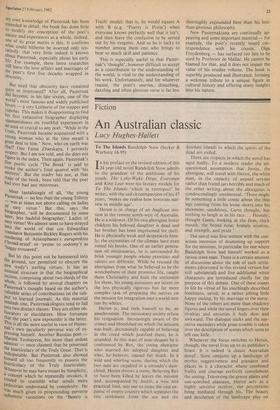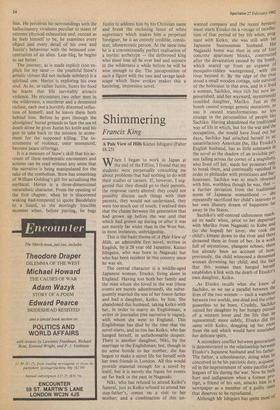Fiction
An Australian classic
Lucy Hughes-Hallett
1n his preface to the revised edition of this 24 year-old novel'Randolph Stow admits to the grandeur of the ambitions of his youth. The Lyke-Wake Dirge, Everyman and King Lear were his literary models for To The Islands 'which in retrospect' he writes, with the sad circumspection of his 47 years, 'makes me realise how horizons nar- row in middle age'.
Heriot is in charge of an Anglican mis- sion in the remote north-west of Australia. He is a widower. Of his two aborigine foster children his beloved daughter is dead and her brother has been imprisoned for theft. He is physically weak and desperately lone- ly; the extremities of the climate have even rotted his books. One of an earlier genera- tion of missionaries, he is surrounded by brisk younger people whose priorities and talents are different. While he rescued the aborigines from what he believed to be the wretchedness of their primitive life, taught them Christianity and built the settlement for them, his young assistants are intent on the less physically rigorous but far more complex task of preparing the natives on the mission for integration into a world now run by whites.
Heriot is, and feels himself to be, an anachronism. The missionary society refuse his resignation. Increasingly aware of the crimes and bloodshed on which the mission was built, decreasingly capable of believing in the creed which justified them, he is stranded. In this state of near-despair he is confronted by Rex, the young aborigine who married his adopted daughter and who, he believes, caused her death. In a wild and whirling scene, during which the two men arc engulfed in a tornado's dust- cloud, Heriot throws a stone. Believing Rex to have been killed he leaves the mission and, accompanied by Justin, a wise and practical fool, sets out to cross the vast ex- panse of empty country which separates the tiny settlement from the sea and the desolate islands to which the spirits of the dead are exiled.
There are respects in which the novel has aged badly. To a modern reader the un- questioned assumption that Justin, the aborigine, will travel with Heriot, the white man, in the capacity of unpaid servant rather than friend jars horribly and much of the other writing about the aborigines is condescendingly sentimental. 'There might be something a little comic about the thin legs running from his loose shorts into his enormous sandshoes, Gunn thought, but nothing to laugh at in his face... Homely, thought Gunn, looking at the firm, thick mouth, the broad nose; homely wisdom, and strength, and pride.'
The novel was first written with the con- scious intention of drumming up support for the missions, in particular for one where Randolph Stow had himself worked as a ration-store man. There is a certain amount of discussion about the role of such settle- ments (shortened in this revised version but still substantial) and five additional white characters are introduced chiefly for the purpose of this debate. One of these comes to life by virtue of his touchingly described loneliness, saved, in a rather jolting little happy ending, by his marriage to the nurse. None of the others are more than shadowy , figures and while the novel lingers over their rivalries and anxieties it feels slow and awkward. The dialogue sticks and the nar- rative meanders while great trouble is taken over the description of scenes which seem to tell one little.
Whenever the focus switches to Heriot, though, the novel lives up to its publisher's boast. It is indeed 'a classic Australian novel'. Stow conjures up a landscape of mythic suggestiveness and grandeur and places in it a character whose combined frailty and courage perfectly complement the setting. Traversing the grassy plains and sun-scorched plateaux, Heriot acts as a highly sensitive receiver, our perceptions being mediated through his. The beauty and desolation of the landscape play on
him. He perceives his surroundings with the hallucinatory vividness peculiar to states of extreme physical exhaustion and, outcast as he feels himself to be, he examines every object and every detail of his own and Justin's behaviour with the bemused con- centration of an alien. Lear-like, he begins to see better.
The journey, as is made explicit (too ex- plicit for my taste — the youthful Stow's artistic virtues did not include subtlety) is a spiritual one. Heriot is exploring his own soul. As he, or rather Justin, hunts for food he learns that life inevitably attracts violence. He encounters two other men in the wilderness, a murderer and a demented recluse, each one a horribly distorted reflec- tion of himself, and he leaves them both behind him. Before he goes through the aborigines' burial grounds to face the sea of death alone he gives Justin his knife and his gun to take back to the mission in atone- ment for the supposed killing. The in- struments of violence, once renounced, become peace offerings.
It is a measure of Stow's skill that his ac- count of these emblematic encounters and actions can be read without any sense that the narrative is being manipulated for the sake of the symbolism. Stow has something of William Golding's gift for actualising the mythical. Heriot is a three-dimensional naturalistic character. From the opening of the first chapter, when he is discovered waking bad-tempered to quote Baudelaire to a lizard, to the movingly irascible moment when, before parting, he begs Justin to address him by his Christian name and break the enclosing fence of white supremacy which makes him a perpetual foreigner, he is an entirely credible, consis- tent, idiosyncratic person. At the same time he is a conventionally perfect realisation of a mythic archetype — the dethroned king who must lose all he ever had and sojourn in the wilderness a while before he will be wise enough to die. The juxtaposition of such a figure with the vast and savage land- scape which Stow evokes makes this a haunting, impressive novel.





































 Previous page
Previous page